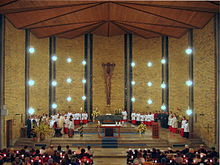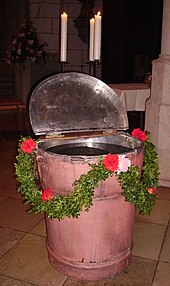Catechumenate
In Christianity, the catechumenate describes the preparation of applicants for baptism ( catechumens ) for admission to the Church through baptism .
In some Protestant churches, the preparation time for confirmation is also referred to as the catechumenate.
history
In the early Christian period up to the 6th century, in addition to Jews, mainly adult pagans converted to Christianity , who were made familiar with Christianity and instructed in the faith for a period of two to three years before their baptism. As a rule, a distinction was made between two levels:
- the Audientes ("listeners") or κατηχούμενοι (more rarely: χριστιανοί), who were interested in joining the church, but were only allowed to listen to the biblical readings and the sermon, but had to leave the room before the celebration of the Eucharist and also at certain were not allowed to participate in other church activities,
- the Competentes (in Rome: Electi , "chosen") or φωτιζόμενοι ( photizómenoi , "who are enlightened"), who after an examination (election) were accepted by the laying on of hands and prayer among the baptismal candidates and were about to be baptized. They attended special meetings with lectures and prayers for deliverance from evil. The basis was the explanation of the creed that the baptismal applicant made at his baptism, which at that time was only or preferably donated on Easter vigil. In addition, there were introductions to Christian moral teaching , the basic prayers and the ten commandments .
In the Middle Ages , infant baptism became the norm, and catechesis was thus placed behind the act of baptism. Adult baptisms were rare except in mission areas.
Catechumenate in the Roman Catholic and Protestant Church

With the Second Vatican Council, the Roman Catholic Church resolved to restore the catechumenate before adult baptism worldwide (Liturgy Constitution "Sacrosanctum Concilium" No. 64.)
In the last few decades there were more adult baptisms in Germany than in the past. One reason for this lies in the reunification of Germany with the following population mix. As a result, many unbaptized adults chose to believe. The Catholic and Protestant churches reacted to this with a conscious renewal of the introduction to adult baptism and thus also of adult catechesis. The basis is the knowledge that the necessary imparting of religious knowledge must be connected with getting to know the congregation , living with the church year and the spiritual accompaniment of the baptismal applicant. That is why the early Christian stages of admission have been reintroduced in a renewed form, in that the journey of the catechumenate is accompanied by various small celebrations (admission to the catechumenate, blessing , anointing with the catechumenate oil ). At the end of this path there is the baptism, possibly in the liturgy of the Easter Vigil . There is no uniform order for the duration and the curriculum of the catechumenate in either the Catholic or the Protestant Church.
In some Protestant churches, the preparation time for confirmation is also referred to as the catechumenate, sometimes also the first year of this time (young people in the first year: catechumens; in the second year: confirmants).
Catechumenate in evangelical free church communities
The Evangelical Free Church congregations , which, as members of the Baptist denominational family, reject infant baptism and only practice Christian baptism, offer baptismal preparation for baptism applicants and those interested in baptism. While the basic faith course deals with the central topics of following Christ , the baptism course, which often follows the basic course, primarily deals with baptismal and congregational teaching, but also sets pastoral accents. The Evangelical Free Church catechumenate also includes conversations between the candidate for baptism and members of the community leadership and his or her baptismal companion. At the end of the preparation for baptism, the person being baptized is presented with a personal confession of faith in front of the assembled congregation, the baptism recommendation of his interlocutor and the acceptance into the congregation to be carried out after his baptism with the laying on of hands.
literature
- Franz-Peter Tebartz-van Elst : Handbook of adult baptism: liturgy and proclamation in the catechumenate. Aschendorff-Verlag , Münster 2002, ISBN 3-402-05384-5 .
- Eugen Paul: History of Christian Education. Volume 1, Antiquity and the Middle Ages . Freiburg / Basel / Vienna 1993, ISBN 3-451-23051-8 : here Chapter III (The Catechumenate in the First Three Centuries, pp. 38–60) and Chapter V (The Catechumenate in the Imperial Church Times, pp. 75–114 ).
- Marcel Metzger, Heinzgerd Brakmann: Art. Catechumenate. In: Real Lexicon for Antiquity and Christianity . Vol. 20, Stuttgart 2003, pp. 497-574.
- Hinrich Schmidt: Experience baptism. A baptismal course in six chapters. For baptism applicants and those interested in baptism. Kassel 2005, ISBN 978-3-87939-753-2 (Evangelical Free Church Baptism Course).
Web links
Individual evidence
- ↑ 64. A multi-level catechumenate for adults is to be restored and introduced according to the judgment of the local ordinary. The aim is to make it possible for the time of the catechumenate, which is intended to be properly introduced, to be sanctified by sacred rites that follow one another at certain times.
